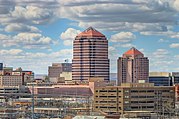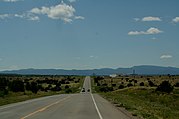Albuquerque metropolitan area
Albuquerque Metropolitan Area | |
|---|---|
|
(top-to-bottom, left-to-right) Panorama of the city of Albuquerque; San Felipe de Neri Church in Old Town Albuquerque; Downtown Albuquerque; Fred Harvey Company Harvey House museum in Belen; Moriarty municipal; Los Lunas; Intel Fab 11x in Rio Rancho; village hall in Los Ranchos; Rio Grande Bosque near Bernalillo; U.S. Route 66 in New Mexico; panorama from the Sandia Mountains peak | |
 | |
| Country | |
| State | |
| Statistical Area | Albuquerque–Santa Fe–Los Alamos combined statistical area |
| Principal counties (cities) | |
| Area | |
• Total | 9,297 sq mi (24,080 km2) |
| Elevation (Average height) | 5,312 ft (1,619 m) |
| Highest elevation (Sandia Mountains Crest) | 10,678 ft (3,255 m) |
| Lowest elevation (Near the Rio Grande, south of Jarales) | 4,767 ft (1,453 m) |
| Population | |
• Total | 915,927[1] |
| • Density | 95/sq mi (37/km2) |
| GDP | |
| • MSA | $53.862 billion (2022) |
| Time zone | UTC−7 (MST) |
| • Summer (DST) | UTC−6 (MDT) |
The Albuquerque Metropolitan Statistical Area, sometimes referred to as Tiguex (named after the Southern Tiwa),[3][4][5] is a metropolitan area in central New Mexico centered on the city of Albuquerque. The metro comprises four counties: Bernalillo, Sandoval, Torrance, and Valencia. As of the 2010 United States Census, the MSA had a population of 887,077.[6] The population is estimated to be 923,630 as of July 1, 2020,[7] making Greater Albuquerque the 61st-largest MSA in the nation. The Albuquerque MSA forms a part of the larger Albuquerque–Santa Fe–Los Alamos combined statistical area with a 2020 estimated population of 1,165,181, ranked 49th-largest in the country.
History
[edit]It was the center of the Aztec legend of the Seven Cities of Gold, sometimes called the "cities of Cibola". The Tiguex Province of Santa Fe de Nuevo México was named after the Southern Tiwa speaking Puebloans in the area, they inhabited the area along with the Jemez and Keres people. The area between Bernalillo and Corrales was being farmed for sacramental wine since 1620, which started the New Mexico wine heritage. Following this early wine industry several Spanish towns were founded, including Barelas in 1662 and Bernalillo in 1695. The main city, Albuquerque, was founded on 1706 as La Villa de Alburquerque as the trade center for the region. During the 19th century, Nuevo México and its Tiguex Province were acquired by the United States as a part of the Treaty of Guadalupe Hidalgo. Becoming the New Mexico Territory it became a prominent aspect of the American frontier during the 19th century, being highlighted in Western fiction with Billy the Kid, Elfego Baca, and Geronimo becoming lasting icons in later adaptation to film. In the 20th century New Mexico gained statehood, and since then trade in the region grew due to growth in technology, media, and agriculture sectors, driven by the New Mexico Technology Corridor, media in Albuquerque, and New Mexican cuisine.
Counties
[edit]Communities
[edit]Cities
[edit]- Albuquerque (Principal city) 562,599
- Belen 7,423
- Moriarty 1,940
- Rio Communities 4,977
- Rio Rancho 105,815
Towns
[edit]Villages
[edit]- Bosque Farms
- Corrales
- Cuba
- Encino
- Jemez Springs
- Los Lunas
- Los Ranchos de Albuquerque
- San Ysidro
- Tijeras
- Willard
Census-designated places
[edit]- Algodones
- Carnuel
- Casa Colorada
- Cedar Crest
- Chilili
- Cochiti
- El Cerro-Monterey Park
- Isleta Village Proper
- Jarales
- Jemez Pueblo
- La Jara
- Los Chavez
- Los Trujillos-Gabaldon
- Manzano
- Meadow Lake
- North Valley
- Paradise Hills
- Peña Blanca
- Placitas
- Ponderosa
- Pueblo of Sandia Village
- Regina
- Rio Communities North
- Rio Communities
- San Felipe Pueblo
- Santa Ana Pueblo
- Santo Domingo Pueblo
- South Valley
- Tajique
- Tome-Adelino
- Torreon (Sandoval County)
- Torreon (Torrance County)
- Valencia
- Zia Pueblo
Partial inclusions and future developments
[edit]Neighboring Laguna Pueblo borders the metropolitan area, and part of its boundaries are included the metropolitan population. Most notably the area surrounding Route 66 Resort and Casino.
Mesa del Sol in Albuquerque and Santolina on the West Mesa in rural Bernalillo County are planned for 100,000 inhabitants each and are New Mexico's largest such planned developments.[8][9]
Demographics
[edit]| Census | Pop. | Note | %± |
|---|---|---|---|
| 1900 | 28,630 | — | |
| 1910 | 23,606 | −17.5% | |
| 1920 | 29,855 | 26.5% | |
| 1930 | 45,430 | 52.2% | |
| 1940 | 69,391 | 52.7% | |
| 1950 | 145,675 | 109.9% | |
| 1960 | 321,982 | 121.0% | |
| 1970 | 379,085 | 17.7% | |
| 1980 | 523,105 | 38.0% | |
| 1990 | 599,416 | 14.6% | |
| 2000 | 729,649 | 21.7% | |
| 2010 | 887,077 | 21.6% | |
| 2020 | 916,528 | 3.3% | |
| U.S. Decennial Census[10][11] | |||
As of the 2010 United States Census, there were 887,077 people, 347,366 households, and 222,811 families residing within the MSA. The racial makeup of the MSA was 49.63% White, 2.68% African American, 5.86% Native American, 2.02% Asian, 0.10% Pacific Islander, 15.40% from one other race, and 4.32% from two or more races. Hispanic or Latino of any race were 46.70% of the population.
The median income for a household in the MSA was $47,383 and the median income for a family was $59,158. Males had a median income of $31,486 versus $20,497 for females. The per capita income for the MSA was $25,044.[12]
According to 2014-2018 census data, 89.7% of the population was a high school graduate or higher, and 34.7% had a bachelor's degree or higher.[13]
Labor force
[edit]Albuquerque MSA Estimated Employment (August 2006)
| Bernalillo County | 304,855 |
| Sandoval County | 48,055 |
| Torrance County | 16,021 |
| Valencia County | 30,591 |
| Total | 399,522 |
| Source: New Mexico Department of Labor [14] | |
See also
[edit]- List of metropolitan areas in New Mexico
- List of micropolitan areas in New Mexico
- List of cities in New Mexico
References
[edit]- ^ "Demographics". Albuquerque Business Expansion | Business Friendly Environment | Albuquerque Economic Development AED. Retrieved February 22, 2015.
- ^ "Total Gross Domestic Product for Albuquerque, NM (MSA)". Federal Reserve Economic Data. Federal Reserve Bank of St. Louis.
- ^ Casselle, T. (2010). Insiders' Guide to Albuquerque. Insiders' Guide Series (in Kurdish). Insider's Guide. p. 34. ISBN 978-0-7627-6278-1. Retrieved June 30, 2022.
- ^ Lavender, D. (1984). The Southwest. University of New Mexico Press. p. 73. ISBN 978-0-8263-0736-1. Retrieved June 30, 2022.
- ^ Zimmerman, R.M. (2019). History Lover's Guide to Albuquerque, A. History and Guide Series. History Press. p. 23. ISBN 978-1-4671-4205-2. Retrieved June 30, 2022.
- ^ "Census data" (PDF). www.census.gov. 2010. Retrieved 2020-04-13.
- ^ List of Metropolitan Statistical Areas
- ^ Metcalf, Richard (March 1, 2008). "Mesa del Sol Reshapes Region". nreionline.com. Retrieved Mar 1, 2008.
- ^ "Santolina Master Plan". www.bernco.gov.
- ^ "U.S. Decennial Census". United States Census Bureau. Archived from the original on May 7, 2015. Retrieved May 28, 2013.
- ^ "Cumulative Estimates of Resident Population Change and Rankings for Metropolitan Statistical Areas in the United States and Puerto Rico: April 1, 2010 to July 1, 2019" (PDF). United States Census Bureau. 2019. Retrieved May 31, 2020.
- ^ "Explore Census Data". United States Census Bureau. Retrieved 26 May 2020.
- ^ "Demographics". City of Albuquerque. Retrieved 2021-01-20.
- ^ "New Mexico Department of Labor". Archived from the original on 2000-05-10. Retrieved 2020-04-13.












